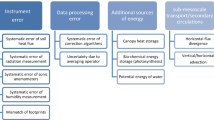Abstract
We have studied the role of low-level clouds in modifying the thermodynamic and turbulence properties of the Arctic boundary layer during autumn. This was achieved through detailed analyses of boundary-layer properties in two regions, one with low-level cloud cover and the other free of clouds, using measurements from a research aircraft during the Beaufort and Arctic Storms Experiment (BASE). Both regions were measured on the same day under similar synoptic forcing. The cloudy region was characterized by strong horizontal inhomogeneity in low-level temperature and moisture that varied with the cloud-top height. The clear region was relatively homogeneous in temperature and specific humidity with a strong temperature inversion extending between heights of 100 m and 3 km. From measurements at the lowest levels, we also identified a shallow mixed layer below the deep stable layer in the clear region.
Our spectral analyses revealed significant modifications of boundary-layer properties due to the presence of low-level clouds. In the cloudy region, turbulent perturbations dominated the boundary-layer flow and made large contributions to the scalar variances. In the clear boundary-layer, wave motion contributed significantly to the observed variances, while turbulent flow was relatively weak. The clear region was saturated, although no detectable clouds were measured.
Similar content being viewed by others
References
Curry, J. A.: 1986, ‘Interactions among Turbulence, Radiation, and Microphysics in Arctic Stratus Clouds’, J. Atmos. Sci. 43, 90-106.
Curry, J. A. and Ebert, E. E.: 1992, ‘Annual Cycle of Radiative Fluxes over the Arctic Ocean: Sensitivity to Cloud Optical Properties’, J. Climate 5, 1267-1280.
Curry, J. A., Meyer, F. G., Radke, L. F., Brock, C. A., and Ebert, E. E.: 1990, ‘The Occurrence and Characteristics of Lower Tropospheric Ice Crystals in the Arctic’, Int. J. Climatol. 10, 749-764.
Curry, J. A., Pinto, J. O., Benner, T., and Tschudi, M.: 1997, ‘Evolution of the Cloudy Boundary Layer during the Autumnal Greezing of Beaufort Sea’, J. Geophys. Res. 102, 13,851-13,860.
Hanesiak, J. M., Stewart, R. E., Szeto, K. K., Hudak, D. R., and Leighton, H.G.: 1997, ‘The Structure, Water Budget and Radiational Features of a High Latitude Warm Front’, J. Atmos. Sci. 54, 1553-1573.
Herman, G. F. and Goody, R.: 1976, ‘Formation and Persistence of Summertime Arctic Stratus Clouds’, J. Atmos. Sci. 32, 1537-1553.
Huschke, R. E.: 1969, ‘Arctic Cloud Statistics from Air-Calibrated Surface Weather Observations’. The Rand Corporation, RM-6173-PR.
Jayaweera, K. and Ohtake, T.: 1973, ‘Concentration of Ice Crystals in Arctic Stratus Clouds’, J. Rech. Atmos. 7, 199-207.
NCAR RAF Bulletin No. 3, http://raf.atd.ucar.edu/Bulletins/bulletin3.html.
Nicholls, S.: 1984, ‘The Dynamics of Stratocumulus: Aircraft Observations and Comparisons with a Mixed Layer Model’, Quart. J. Roy. Meteorol. Soc. 110, 783-820.
Paluch, I. R. and Lenschow, D. H.: 1991, ‘Stratiform Cloud Formation in the Marine Boundary Layer’, J. Atmos. Sci. 48, 2141-2158.
Paluch, I. R., Lenschow, D. H., and Wang, Q.: 1997, ‘The Arctic Boundary Layer in the Fall Season over Open and Frozen Sea’, J. Geophys. Res. 102, 25,955-25,971.
Pinto, J. O.: 1998, ‘Autumnal Mixed-Phase Cloudy Boundary Layers in the Arctic’, J. Atmos. Sci. 55, 2016-2038.
Tsay, S.-C. and Jayaweera, K.: 1984, ‘Physical Characteristics of Arctic Stratus Clouds’, J. Climate Appl. Meteorol. 23, 584-596.
Walter B. and Overland, J. E.: 1991, ‘Aircraft Observations of the Mean and Turbulent Structure of the Atmospheric Boundary Layer during Spring in the Central Arctic’, J. Geophys. Res. 96, 4663-4673.
Wang, Q.: 1993, ‘Turbulent Mixing and Transport in Marine Stratocumulus-Topped Boundary Layers-An Observational Study’, Ph.D. dissertation, Department of Meteorology, The Pennsylvania State University, University Park, PA, 199 pp.
Wang, S., Wang, Q., Jordan, R. E., and Persson, P. O.: 2001, ‘Interactions among Longwave Radiation of Clouds, Turbulence and Snow Surface Temperature in the Arctic: A Model Sensitivity Study’, J. Geophys. Res. 106, 15,323-15,333.
Warren, S. G., Hahn, C. J., London, J., Chervin, R. M., and Jenne, R. L.: 1986, ‘Global Distribution of Total Cloud Cover and Cloud Type Amounts over Land’, NCAR/TN-273+str, National Center for Atmopheric Research, Boulder, CO, 29 pp. and 199 maps.
Author information
Authors and Affiliations
Corresponding author
Rights and permissions
About this article
Cite this article
Wang, Q., Wang, S. Turbulent and Thermodynamic Structure of the Autumnal Arctic Boundary Layer Due to Embedded Clouds. Boundary-Layer Meteorology 113, 225–247 (2004). https://doi.org/10.1023/B:BOUN.0000039375.41823.22
Issue Date:
DOI: https://doi.org/10.1023/B:BOUN.0000039375.41823.22




